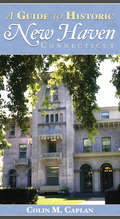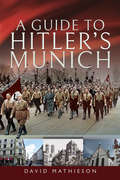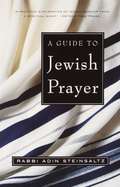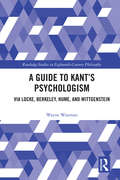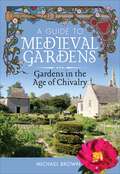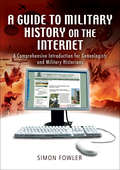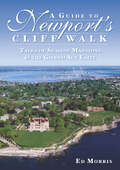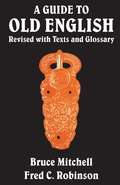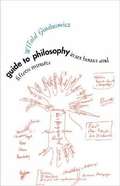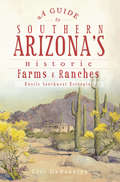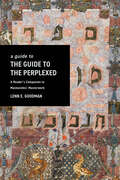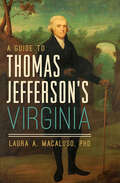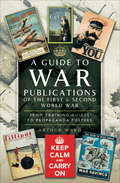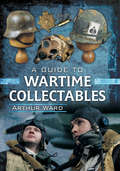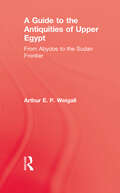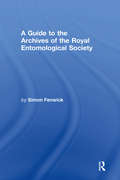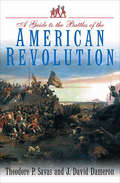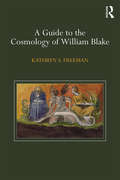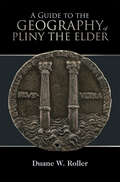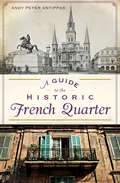- Table View
- List View
A Guide to Historic New Haven, Connecticut (History & Guide)
by Colin M. CaplanAuthor Colin M. Caplan is a native of New Haven and an active member of the local architecture and preservation community. He founded Magrisso Forte, a design-based consulting firm dedicated to fostering awareness of New Haven's cultural resources. This book details eighteen walks and nine guided driving/biking tours around the city.
A Guide to Historic Staunton, Virginia (History & Guide)
by Edmund D. PotterUnlike many small towns in the South that were occupied by the Union army, beautiful Staunton, Virginia, emerged from the Civil War largely unscathed. Join historianEdmund Potter on a walking tour through the many architectural gems and notable buildings of downtownStaunton's five National Historic Districts. From thepicturesque Wharf Area to the birthplace of Woodrow Wilson to the town's many historically African American businesses, A Guide to Historic Staunton offers visitors and residents alike a deeper appreciation of their remarkable surroundings.
A Guide to Hitler's Munich
by David MathiesonPacked with historically significant locations, this history and guide offers a unique look at Munich as the site of Hitler’s rise to power.Munich is one of Europe's most enchanting cities. It is a delight to explore its cobblestone streets and sunlight boulevards with views of the Bavarian Alps—especially during its world-famous Oktoberfest. Yet many visitors know that Munich also has a dark past. The Bavarian capital played a unique role in the ascent of Adolf Hitler, Nazism, and the Third Reich. It was in Munich that Hitler first entered the murky world of beer Keller politics after the First World War. It was also where he established the fanatical base of his NSDAP party. The city was, in his words, ‘the capital of the movement’.This illustrative new book explains how Munich became inextricably linked with the rise and fall of Nazism. It provides the modern reader with a detailed guide to what happened where in the city, why those events were important in the unfolding history of the Third Reich – and why they remain an important warning today.
A Guide to Hitler's Munich
by David MathiesonPacked with historically significant locations, this history and guide offers a unique look at Munich as the site of Hitler’s rise to power.Munich is one of Europe's most enchanting cities. It is a delight to explore its cobblestone streets and sunlight boulevards with views of the Bavarian Alps—especially during its world-famous Oktoberfest. Yet many visitors know that Munich also has a dark past. The Bavarian capital played a unique role in the ascent of Adolf Hitler, Nazism, and the Third Reich. It was in Munich that Hitler first entered the murky world of beer Keller politics after the First World War. It was also where he established the fanatical base of his NSDAP party. The city was, in his words, ‘the capital of the movement’.This illustrative new book explains how Munich became inextricably linked with the rise and fall of Nazism. It provides the modern reader with a detailed guide to what happened where in the city, why those events were important in the unfolding history of the Third Reich – and why they remain an important warning today.
A Guide to Jewish Prayer
by Adin SteinsaltzOne of the world's most famous and respected rabbis has given us the one guide we need to practice Jewish prayer and understand the prayer book. From the origins and meaning of prayer to a step-by-step explanation of the daily services to the reason you're not supposed to chat with your friends during the service, Rabbi Adin Steinsaltz answers many of the questions likely to arise about Jewish prayer. Here are chapters on daily prayer; Sabbath prayer; prayer services for the holidays; the yearly cycle of synagogue Bible readings; the history and make-up of the synagogue; the different prayer rites for Ashkenazim, Sephardim, Yemenites, and other cultural/geographic groupings; the role of the rabbi and the cantor in the synagogue; and the role of music in the service. The book also contains a glossary, a bibliography, and biographical sketches of the rabbis who were instrumental in creating and ordering the prayers through the ages. Rabbi Steinsaltz's guide is an essential volume both for the newcomer to Jewish prayer and for those who have been engaged in prayer for years. From the Hardcover edition.
A Guide to Kant’s Psychologism: via Locke, Berkeley, Hume, and Wittgenstein (Routledge Studies in Eighteenth-Century Philosophy)
by Wayne WaxmanThis book presents an interpretation of Kant’s Critique of Pure Reason as a priori psychologism. It groups Kant’s philosophy together with those of the British empiricists—Locke, Berkeley, and Hume—in a single line of psychologistic succession and offers a clear explanation of how Kant’s psychologism differs from psychology and idealism. The book reconciles Kant’s philosophy with subsequent developments in science and mathematics, including post-Fregean mathematical logic, non-Euclidean geometry, and both relativity and quantum theory. It also relates Kant’s psychologism to Wittgenstein’s later conception of language. Finally, the author reveals the ways in which Kant’s philosophy dovetails with contemporary scientific theorizing about the natural phenomenon of consciousness and its place in nature. This book will be of interest to Kant scholars and historians of philosophy working on the British empiricists.
A Guide to Medieval Gardens: Gardens in the Age of Chivalry
by Michael Brown&“A fascinating account of formal gardens during the middle ages,&” including plants and their uses, features, tools, cultivation techniques, and more (Books Monthly). Medieval gardens usually rate very few pages in the garden history books. The general perception is still of small gardens in the corner of a castle. Recent research has shown that the gardens were larger than we previously believed. This book contains information and pictures that have not been generally available before, including the theory and practice of medieval horticulture. Many features of later gardens were already a part of medieval gardens. The number of plants was limited, but was still no less than many modern gardeners use in their own gardens today. Yet medieval gardens were imbued with meaning. Whether secular or religious, the additional dimension of symbolism, gave a greater depth to medieval gardens, which is lacking in most modern ones. This book will be of interest to those who know little about medieval gardens and to those with more knowledge. It contains some of the vast amount of research that the author carried out to create the medieval gardens at the Prebendal Manor, Nassington, Northamptonshire. The author has tried to use previously unused sources and included his own practical experience of medieval gardening methods that he carried out to maintain the gardens. &“Beautifully illustrated . . . a fascinating read for the armchair gardener as well as the more practical variety . . . The author draws on a wide range of sources: herbals, animal management, medieval manuals, illuminated manuscripts, account books, poems, paintings, and tapestries.&” —The Ricardian Bulletin
A Guide to Military History on the Internet: A Comprehensive Introduction for Genealogists and Military Historians
by Simon FowlerThere are thousands of websites devoted to all aspects of military history from ancient Greece to the modern Gulf. This unique book helps you find the ones that will help with your research whether you are checking out a soldier ancestor or an airman or researching a naval campaign. It also features sites that are entertaining or controversial. Sections cover the British armed services and their long military history, but the author also describes in detail websites that focus on American and Canadian forces. A Guide to Military History on the Internet is a companion volume to Pen & Sword's best-selling Tracing Your Army Ancestors by the same author.
A Guide to Newport's Cliff Walk: Tales of Seaside Mansions & the Gilded Age Elite (History And Guide Ser.)
by Ed MorrisA revealing tour of the opulent Newport Mansions where the Astors, Vanderbilts, and other Gilded Age families spent their summers. At the turn of the twentieth century, the wealthy families of New York would vacation at their summer homes in Newport, Rhode Island. Where the salty air once mingled with the laughter of society women in ball gowns, the houses of the Newport Cliff Walk still preside in grandeur over the crashing waves below. From the grand majesty of the Breakers to the beautiful proportions of Rosecliff, these houses are enduring reminders of the architectural flowering of the Gilded Age. Walking along the paved trail, it's easy to imagine the faintest hint of a waltz coming from the windows of Beechwood, or to envision the Duchess of Windsor&’s carriage arriving for a visit at Fairholme. Ed Morris takes you on a tour of twenty-four historic mansions and landmarks, entertaining along the way with tales of splendor and style, social maneuvering and matchmaking.
A Guide to Old English: Revised with Texts and Glossary (The Royal Society of Canada Special Publications)
by Bruce Mitchell Fred RobinsonA Guide to Old English has established itself as the most thorough and most stimulating introduction to the language of Anglo-Saxon England. This revised edition adds ten basic texts, together with full notes and a comprehensive glossary, which convert the Guide into a self-contained course book for students beginning a study of Old English. The texts, such as Cynewulf and Cyneheard, the story of Caedmon and the conversion of Edwin, are those that have traditionally been chosen by teachers precisely becasue they offer the best introduction to the literature and culture of the time. They are arranged in order of increasing difficulty. The notes and glossary constantly refer to the grammatical explanations in the Guide, so that course is fully integrated and easy to follow.
A Guide to Olde York: The White Rose Tour (History & Guide)
by Yorkville Historical SocietyWelcome to York, a city that can trace its beginnings to the origins of York County, South Carolina. Explore the thirty different styles of architecture in a compact historic district that is listed in the National Register of Historic Places. Within three blocks, discover how an elephant brought Santa Claus into town. Walk the paths of Catawba and Cherokee warriors and chiefs, as well as where leaders and militia rode during the Revolutionary War. And imagine the sights and sounds as Jefferson Davis gave his last public address before the cabinet of the Confederacy dissolved. The Yorkville Historical Society offers this fascinating history and more in a guided tour through the White Rose City.
A Guide to Philosophy in Six Hours and Fifteen Minutes
by Witold Gombrowicz Benjamin IvryWitold Gombrowicz (1904-1969), novelist, essayist, and playwright, was one of the most important Polish writers of the twentieth century. A candidate for the Nobel Prize in Literature in 1968, he was described by Milan Kundera as "one of the great novelists of our century" and by John Updike as "one of the profoundest of the late moderns. " Gombrowicz's works were considered scandalous and subversive by the ruling powers in Poland and were banned for nearly forty years. He spent his last years in France teaching philosophy; this book is a series of reflections based on his lectures. Gombrowicz discusses Kant, Hegel, Schopenhauer, Kierkegaard, Sartre, and Heidegger in six "one-hour" essays and addresses Marxism in a shorter "fifteen-minute" piece. The text-a small literary gem full of sardonic wit, brilliant insights, and provocative criticism-constructs the philosophical lineage of his work.
A Guide to Scholarly Resources on the Russian Empire and the Soviet Union in the New York Metropolitan Area
by Robert A. KarlowichIdentifies collections held by public and university libraries, historical societies, and other institutions, as well as private collections, with material relating to any subject and historical period, and to the widest geographical area under imperial or Soviet rule. Includes movements for example
A Guide to Southern Arizona's Historic Farms and Ranches: Rustic Southwest Retreats (History And Guide Ser.)
by Lili DebarbieriExperience southwestern heritage, culture and cuisine while learning to rope and herd cattle, trail ride through the wilderness or make prickly pear syrup. With roots dating back to the mid-1800s, southern Arizona's historic guest ranches and farm stays include Spain's first mission in the continental United States, a former World War II prison camp and boys' boarding school and a Butterfield Stagecoach stop. Intimately connected to Arizona's land and legacy, these unparalleled retreats have hosted countless artists, movie stars and politicians and continue to enrich their present-day communities through food, education and conservation. Pack your bags and join travel writer Lili DeBarbieri for a journey into the rural west south of the Gila River.
A Guide to The Guide to the Perplexed: A Reader’s Companion to Maimonides’ Masterwork
by Lenn GoodmanIn this volume, noted philosopher Lenn E. Goodman shares the insights gained over a lifetime of pondering the meaning and purpose of Maimonides' celebrated Guide to the Perplexed. Written in the late twelfth century, Maimonides' Guide aims to help religiously committed readers who are alive to the challenges posed by reason and the natural sciences to biblical and rabbinic tradition. Keyed to the new translation and commentary by Lenn E. Goodman and Phillip I. Lieberman, this volume follows Maimonides' life and learning and delves into the text of the Guide, clearly explaining just what Maimonides means by identifying the Talmudic Ma'aseh Bereshit and Ma'aseh Merkavah with physics and metaphysics (to Maimonides, biblical cosmology and theology). Exploring Maimonides' treatments of revelation, religious practice and experience, law and ritual, the problem of evil, and the rational purposes of the commandments, this guide to the Guide explains the tactics Maimonides deployed to ensure that readers not get in over their heads when venturing into philosophical deep waters.
A Guide to Thomas Jefferson's Virginia: History Through Architecture (Landmarks Ser.)
by Laura A. MacalusoTour Thomas Jefferson&’s Virginia, from Monticello to the Blue Ridge Mountains and beyond, with a guide that &“mixes historical background with how-tos&” (Daily Press). Few prominent Americans are as associated with a place as Thomas Jefferson is with Virginia. The heart of &“Jefferson Country&” is his house and plantation at Monticello, but Jefferson traveled the breadth of his home state, from his time at the College of William and Mary in Williamsburg to the new state capital at Richmond and his retreat and plantation at Poplar Forest, near Lynchburg. While spending time in the beauty of the Blue Ridge Mountains, Jefferson was inspired to write his only book, Notes on the State of Virginia. Jefferson&’s life story, and his many endeavors as a scholar and statesman, are illustrated in this guide to the state he held dear. &“This book mixes historical background with the how-tos of visiting the places Jefferson spent time, including the Wren Building at the College of William and Mary, which he attended, and the George Wythe house, where he studied law in Williamsburg.&” —Daily Press
A Guide to War Publications of the First & Second World War: From Training Guides to Propaganda Posters
by Arthur WardA &“fascinating&” guide to war propaganda of WWI and WWII, from &“Loose Lips Sink Ships&” to &“Keep Calm and Carry On&”—includes vintage images (Firetrench). A Guide to War Publications of the First & Second World War is devoted to the printed ephemera that was designed to educate, instruct, inform, and entertain during the first and second World Wars. This includes soldiers&’ Field Regulations, updates airmen received about airborne early warnings, bomb sights, and radio navigation, and materials sailors were given to help them identify enemy aircraft and operate new weapons on submarines. This comprehensive guide illustrates the large amount of material produced during the war by looking at encouraging wartime sayings such as: &“Go To IT!,&” &“Come Into The Factories,&” &“Keep Calm and Carry On,&” &“Dig for Victory,&” &“Lend A Hand on the Land,&” and &“Walk When You Can.&” While showing how other messages warned of consequences to irresponsible behavior: &“Careless Talk Cost Lives,&” &“Loose Lips Sink Ships,&” &“Keep It Under Your Hat,&” and &“Be Like Dad, Keep Mum.&” Arthur Ward gives information on what propaganda was produced, what items are still available and where to find them, and how to conserve and store vintage printed items.
A Guide to Wartime Collectables: An Enthusiast's Guide To Militaria
by Arthur WardMake sure you&’re getting the genuine article with this &“well-illustrated&” guide and &“must read&” for collectors of twentieth-century military memorabilia (Antiques Diary). Written by a longtime collector, A Guide to Wartime Collectables tells readers what to look for when looking for authentic military items. From army badges to gas masks, this book covers the major types of twentieth-century military collectables. Arthur Ward shows what these items look like and what new collectors should be looking for to ensure they&’re purchasing authentic artifacts and not reproductions. This book also includes photographs of the author&’s collection that feature important details such as insignias and other regalia. &“A very useful book written by an author who knows his stuff.&” —The Armourer
A Guide to Your History Course: What Every Student Needs to Know "
by Vincent Alan ClarkHistory students are like travelers in a foreign country. They can benefit from a guidebook that provides orientation, information about important sites, and helpful information for solving practical problems. "A Guide to Your History Course" is designed to show them the way.
A Guide to the Antiquities of Upper Egypt: From Abydos To The Sudan Frontier (Cambridge Library Collection - Egyptology Ser.)
by Arthur E. WeigallFirst published in 2005. Routledge is an imprint of Taylor & Francis, an informa company.
A Guide to the Archives of the Royal Entomological Society
by Simon FenwickThe Royal Entomological Society was founded in 1833 and is one of the oldest such societies in the world. Its records are an invaluable source for historians of entomology and the natural sciences both in Great Britain and overseas. This guide is principally a catalogue of the records of the society from the time of its foundation, but also covers the records of some earlier societies and collections of papers by individual entomologists. The book is introduced with essays by Brian Gardiner on the history of the Royal Entomological Society and on the development of British entomology, and by Simon Fenwick on the archives and their potential for historians.
A Guide to the Battles of the American Revolution
by J. David Dameron Theodore P. SavasA Guide to the Battles of the American Revolution is the first comprehensive account of every engagement of the Revolution, a war that began with a brief skirmish at Lexington Green on April 19, 1775, and concluded on the battlefield at the Siege of Yorktown in October 1781. In between were six long years of bitter fighting on land and at sea. The wide variety of combats blanketed the North American continent from Canada to the Southern colonies, from the winding coastal lowlands to the Appalachian Mountains, and from the North Atlantic to the Caribbean. Unlike existing accounts, A Guide to the Battles of the American Revolution presents each engagement in a unique way. Each battle entry offers a wide and richbut consistenttemplate of information to make it easy for readers to find exactly what they are seeking. Every entry begins with introductory details including the date of the battle, its location, commanders, opposing forces, terrain, weather, and time of day. The detailed body of each entry offers both a Colonial and British perspective of the unfolding military situation, a detailed and unbiased account of what actually transpired, a discussion of numbers and losses, an assessment of the consequences of the battle, and suggestions for further reading. Many of the entries are supported and enriched by original maps and photos. Fresh, scholarly, informative, and entertaining, A Guide to the Battles of the American Revolution will be welcomed by historians and general enthusiasts everywhere.
A Guide to the Cosmology of William Blake
by Kathryn S. FreemanIt is not surprising that visitors to Blake’s cosmology – the most elaborate in the history of British text and design – often demand a map in the form of a reference book. The entries in this volume benefit from the wide range of historical information made available in recent decades regarding the relationship between Blake’s text and design and his biographical, political, social, and religious contexts. Of particular importance, the entries take account of the re-interpretations of Blake with respect to race, gender, and empire in scholarship influenced by the groundbreaking theories that have arisen since the first half of the twentieth century. The intricate fluidity of Blake’s anti-Newtonian universe eludes the fixity of definitions and schema. Central to this guide to Blake's work and ideas is Kathryn S. Freeman's acknowledgment of the paradox of providing orientation in Blake’s universe without disrupting its inherent disorientation of the traditions whereby readers still come to it. In this innovative work, Freeman aligns herself with Blake’s demand that we play an active role in challenging our own readerly habits of passivity as we experience his created and corporeal worlds.
A Guide to the Geography of Pliny the Elder
by Duane W. RollerThis is the first thorough English commentary on the geographical books of Pliny the Elder, written in the AD 70s. Pliny's account is the longest in Latin, and represents the geographical knowledge of that era, when the Roman Empire was the dominant force in the Mediterranean world. The work serves both cultural and ideological functions: much of it is topographical, but it also demonstrates the political need to express a geographical basis for the importance of the Roman state. In five books, Pliny covers the entire world as it was known in his era and includes some of the first information on the extremities of the inhabited region, including Scandinavia and the Baltic, eastern Asia, and sub-Saharan Africa. The commentary provides a detailed analysis of all the points Pliny raises: his sources, toponyms, and understanding of the place of the earth in the cosmos.
A Guide to the Historic French Quarter (History And Guide Ser.)
by Andy Peter AntippasFrom Bourbon Street to Pirate&’s Alley and beyond—a local historian takes you on a walking tour of the historic French Quarter in New Orleans. Walking through the French Quarter can overwhelm the senses—and the imagination. The experience is much more meaningful with knowledge of the area&’s colorful history. For instance, the infamous 1890 &“separate but equal&” legal doctrine justifying racial segregation was upheld by the Louisiana Supreme Court at the Cabildo on Jackson Square. In the mid-twentieth century, a young Lee Harvey Oswald called Exchange Alley home. One of New Orleans&’s favorite cocktails—the sazerac—would not exist if Antoine Peychaud had not served his legendary bitters with cognac from his famous apothecary at 437 Royal. Local author Andy Peter Antippas presents a walking history of the Vieux Carre, one alley, corner and street at a time.
